Navratri, a festival celebrated across India with great fervor, marks the worship of Goddess Durga and signifies the triumph of good over evil. During this nine-day festival, devotees observe fasts and indulge in special foods that are prepared without onions, garlic, and non-vegetarian ingredients. The Navratri thali, a showcase of diverse flavors and textures, is a culinary delight that reflects both tradition and creativity. Let's delve into the intricacies of crafting a delectable Navratri thali, exploring its components and the cultural significance behind this festive feast.
The Essence of Navratri Vrat Thali:
The Navratri thali is a visual and gastronomic feast comprising a balanced assortment of dishes that adhere to fasting restrictions yet burst with flavor. This traditional platter showcases a variety of ingredients and cooking techniques, making it a cherished part of Navratri festivities. The thali typically includes:
1. Sabudana Khichdi: A fragrant and comforting dish made from soaked sago pearls, peanuts, and mild spices. Sabudana khichdi is light yet filling, making it a popular choice during fasting.
2. Kuttu ki Puri: These crispy, golden puris are made from buckwheat flour (kuttu ka atta) and served hot with potato curry or yogurt.
3. Singhare ke Aate ka Halwa: A luscious dessert prepared from water chestnut flour, ghee, sugar, and garnished with nuts. This halwa is rich and satisfying.
4. Aloo Tamatar Sabzi: A simple yet flavorful potato and tomato curry, seasoned with cumin seeds, green chilies, and fresh coriander. It pairs perfectly with kuttu ki puri.
5. Samak Rice Pulao: Nutritious and light, this pulao is made from samak rice (barnyard millet) and combined with vegetables like potatoes and peas.
6. Paneer Kofta: Soft paneer (Indian cottage cheese) dumplings simmered in a creamy tomato-based gravy. Paneer kofta adds a touch of indulgence to the Navratri thali.
7. Fruit Salad: A refreshing medley of seasonal fruits, often served as dessert to cleanse the palate after a satisfying meal.
8. Makhana Kheer: A delightful pudding made from fox nuts (makhana), milk, and sugar, garnished with saffron and nuts. Makhana kheer is a luxurious treat during Navratri.
9. Fresh Yogurt: Cooling and essential, plain yogurt complements the spicier components of the thali and aids digestion.
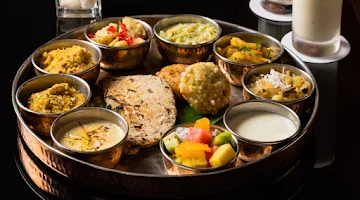
Image courtesy: Elle India
Significance of Fasting and Food Choices:
Fasting during Navratri is not merely about abstaining from certain foods but also about spiritual purification and renewal. Many devotees choose to eat sattvic (pure) foods that are believed to promote positivity and harmony within the body and mind. By eliminating heavy spices, onions, garlic, and non-vegetarian items, the Navratri thali encourages mindful eating and emphasizes the consumption of wholesome, plant-based ingredients.
Also Read, Colours of Navratri and its Importance in Bhog
Crafting the Perfect Navratri Thali:
Preparing a Navratri thali requires meticulous planning and attention to detail. Each dish is crafted with care to ensure a harmonious blend of flavors and textures. Here are some tips for creating an impressive Navratri thali:
1. Fresh Ingredients: Use fresh, seasonal produce and quality ingredients to enhance the flavors of your dishes.
2. Balancing Flavors: Aim for a balance of sweet, sour, salty, and spicy flavors across your thali. Incorporate ingredients like rock salt (sendha namak), fresh herbs, and mild spices to achieve this balance.
3. Texture Variety: Include dishes with different textures—crispy, creamy, and soft—to add interest to your thali.
4. Presentation: Pay attention to the presentation of your thali. Use vibrant colors and decorative elements like fresh flowers or traditional serving bowls to create an inviting spread.
5. Customization: Tailor your Navratri thali to suit personal preferences and regional influences. Experiment with unique recipes while staying true to fasting guidelines.
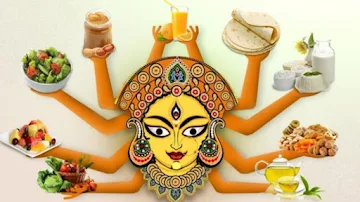
Regional Variations of Navratri Thali Across India:
Navratri, celebrated with fervor across India, manifests uniquely in diverse regional cuisines. Here's a deeper look into the regional variations of Navratri Thali preparations:
Gujarat:
In Gujarat, Navratri is marked by vibrant flavors and innovative dishes. Some popular items include:
Sabudana Vada: Crispy fritters made from soaked sago pearls, potatoes, and spices.
Rajgira Paratha: Flatbread made from amaranth flour, served with yogurt or potato curry.
Kesar Shrikhand: A saffron-infused sweet yogurt dessert, garnished with dry fruits.
Gujarati Navratri thali is known for its light yet indulgent offerings, showcasing the state's culinary finesse.

Image courtesy: Chef Ajay Chopra
North India:
In North India, including Punjab, Rajasthan, and Uttar Pradesh, Navratri brings forth a hearty spread of traditional fasting dishes such as:
Singhare ki Poori: Deep-fried bread made from water chestnut flour, often paired with potato curry or yogurt.
Arbi Tikki: Spiced colocasia (arbi) patties, shallow-fried until crispy.
Kuttu Pakoras: Crisp fritters made from buckwheat flour and mixed with vegetables.
The North Indian Navratri thali is characterized by robust flavors and rustic preparations that resonate with the region's culinary heritage.
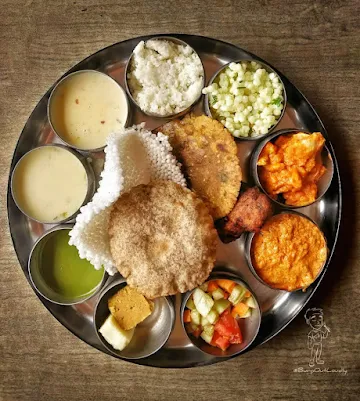
Image courtesy: LBB
Maharashtra:
In Maharashtra, Navratri culinary traditions are deeply rooted in simplicity and local ingredients. Key dishes include:
Sabudana Khichdi: Tapioca pearls sautéed with peanuts, potatoes, and spices.
Sabudana Vada: Deep-fried sago and potato patties, crispy on the outside and soft inside.
Potato-based Curries: Varieties of potato curries seasoned with cumin, green chilies, and coconut.
Maharashtrian Navratri thali showcases comfort foods that are flavorful and satisfying, reflecting the state's cultural richness.
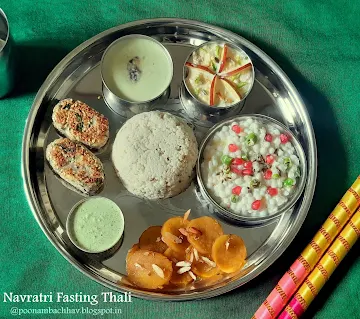
Image courtesy: Poonmabachhav
South India:
In South India, Navratri thali offers a delightful blend of flavors unique to the region:
Mor Kuzhambu: A tangy yogurt-based curry with vegetables, served with steamed rice.
Vazhaipoo Vadai: Crispy fritters made from banana flowers and lentils, a specialty of Tamil Nadu.
Pumpkin Erissery: A Kerala dish made with pumpkin, coconut, and spices, perfect for Navratri fasting.
South Indian Navratri thali highlights the use of coconut, curry leaves, and tangy tamarind flavors, showcasing the region's culinary diversity.
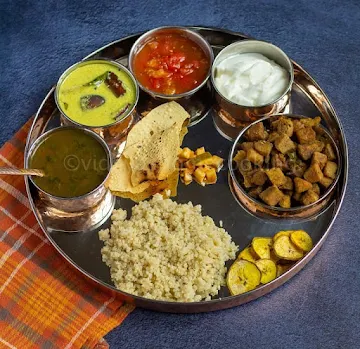
Image courtesy: Vidhya's vegetarian kitchen
West Bengal:
In West Bengal, Navratri or Durga Puja is celebrated with unique fasting dishes like:
Aloo Posto: Potatoes cooked in a poppy seed paste, flavored with mustard oil.
Cholar Dal: Bengal gram lentils cooked with coconut and raisins, offering a sweet-savory flavor.
Narkel Nadu: Coconut and jaggery-based sweets, are a delightful treat during the festive season.
Bengali Navratri Thali exemplifies the state's love for subtle yet distinct flavors, combining sweetness with earthy spices.
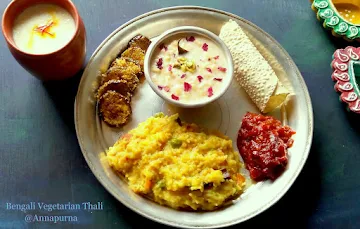
Image courtesy: Annapurna
Cultural Traditions and Festive Atmosphere:
Navratri is not only a time for feasting but also a celebration of community and culture. Families and friends come together to share meals, exchange blessings, and partake in devotional practices. The preparation of the Navratri thali is often a communal effort, with different members contributing their specialties to create a memorable dining experience.
In essence, the Navratri Thali encapsulates the spirit of this auspicious festival—devotion, creativity, and culinary prowess. As you embark on the journey of preparing and enjoying a Navratri thali, savor the rich traditions and the significance of each dish. Let this festive spread be a reflection of reverence and joy, uniting people in the spirit of togetherness and culinary delight during Navratri.
So, gather your ingredients, unleash your culinary flair, and revel in the magic of Navratri with a splendid thali that honors tradition while embracing innovation. Happy Navratri and happy feasting!
5 FAQs Related to Navratri Thali:
Q1. Why are onions, garlic, and non-vegetarian ingredients avoided during Navratri fasting?
Ans: During Navratri, devotees follow certain dietary restrictions as part of their religious observance. Onions and garlic are considered tamasic (foods that evoke negative emotions) in nature according to Ayurveda and are therefore avoided during this period to maintain purity and spiritual clarity. Non-vegetarian ingredients are also excluded as a way of adhering to a vegetarian diet that is considered more conducive to spiritual practices during this auspicious time.
Q2. What are some common substitutes used in Navratri cooking?
Ans: To replace ingredients like onions and garlic in Navratri dishes, cooks often use alternative flavorings such as ginger, green chilies, and asafoetida (hing). These ingredients add depth and flavor to the dishes without compromising the fasting guidelines. Other substitutes include rock salt (sendha namak) instead of regular salt and ingredients like buckwheat flour (kuttu ka atta), water chestnut flour (singhare ka atta), and barnyard millet (samak rice) in place of wheat and rice.
Q3. How can one ensure a balanced and nutritious Navratri thali?
Ans: Creating a balanced and nutritious Navratri thali involves incorporating a variety of ingredients and dishes to cover different nutritional needs. Including foods like potatoes, peanuts, paneer, yogurt, fruits, and nuts ensures that the thali is rich in proteins, carbohydrates, fats, vitamins, and minerals. It's also essential to use a mix of cooking techniques such as boiling, steaming, and shallow frying to retain nutrients while keeping the dishes light and digestible.
Q4. What are some regional variations of Navratri thali across India?
Ans: Navratri thali varies across different regions of India, each reflecting local culinary traditions and flavors. In Gujarat, you might find dishes like sabudana khichdi, kuttu puri, and rajgira paratha dominating the thali. In North India, particularly in Punjab and Rajasthan, dishes like singhare ki poori, arbi tikki, and kuttu pakoras are popular during Navratri. In Maharashtra, Sabudana vada, sabudana khichdi, and potato dishes are commonly enjoyed. These regional variations highlight the diverse and vibrant culinary heritage of India.
Q5. How can one make a Navratri thali more creative and festive?
Ans: To make your Navratri thali more creative and festive, experiment with innovative recipes and presentation ideas while staying true to the fasting guidelines. Try incorporating lesser-known ingredients like amaranth (rajgira), lotus seeds (makhana), and colocasia (arbi) into your dishes. Garnish your thali with edible flowers, fresh herbs, and colorful fruits to enhance its visual appeal. Additionally, involve family members in the cooking process to make it a joyful and collaborative experience.
